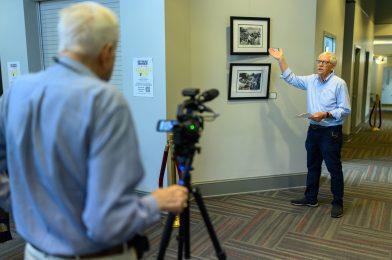Caption: Ron Sherman talks about his work on display at the Roswell Arts Center on Friday, September 23, 2022. [NIKON Z 9, 35mm f/1.4G, Mode = Aperture Priority, ISO 1000, 1/200, ƒ/1.4, (35mm = 35)]
Today I went to hear photojournalist Ron Sherman share some of his 60+ career highlights at the Roswell Cultural Arts Center.
For those who are new to photography and specifically commercial photography, I am writing this to help you understand there is not a well-worn path for newbies to follow those who went before.

Ron is about eighty, so his career started twenty-some years before I entered the profession. Ron’s dream job early on was to be on staff as a photographer for Life Magazine. Unfortunately, Life Magazine went under in 1972, just about when Ron’s portfolio was strong enough to be published.
My dream job was to work for The Commission Magazine, which I did get to do in 1985. However, a few years later, I was laid off due to funding.
Both Ron and I had watched the industry change. Unfortunately, while my 40+ years overlap with Ron’s because of timing, we didn’t get the same opportunities due to changes.
Most of Ron’s career was in the film. Digital capture didn’t take hold of the industry until around 2000. Of course, there were digital cameras earlier, but the quality hadn’t surpassed film, in my opinion, until about 2002 at the earliest.
Ron did well with owning the copyright to his images and selling them through agencies for large sums of money compared to today’s rates. $300 was the lower end of photography stock sales when the film was the standard. Today sales start below $2.
Film cameras required photographers to know what they were doing because it took more than an hour if you process your film to see what you had taken. In addition, the ability to reshoot something because your settings were wrong wasn’t possible with film. Digital changed that in a significant way.
Digital exploded the number of photographers. Finally, they could take a photo and see the results instantaneously. Make a mistake with focus, exposure, or color balance; you can correct your settings and reshoot a photo in seconds. Digital capture was a game changer for the industry.
Most large businesses hire advertising and public relations agencies to hire photographers for commercial work. Photographers created portfolios and showed them to the agencies for work.
Art directors with great eyes didn’t always have the skills to shoot film and make it do what they needed. With digital capture, that changed. As a result, many of those agencies started shooting their photography rather than hiring photographers.
Today it is no longer just about digital capture with professional cameras; smartphones have cameras capable of rendering results good enough for advertising campaigns.
So today, the one thing that isn’t a differentiator for commercial photography is the camera and how to use it.
Today I see these as the differentials for helping photographers stand out and get work.
- Understanding Light – This means the ability to use natural light by moving around until you get the best possible light on the subject.
- Creating Light – Photographers need to know how to start light from scratch in a dark room to work with available light and add lights to make subjects look even better.
- Subject Expertise – Without understanding a subject, you will struggle to take intense photos in communicating this to an audience without someone else directing you. The more you know, the less the client does less directing and looks to you, the photographer, to help them get strong images.
- People Skills – You must be able to listen to your clients and communicate to build trust with everyone involved in a project. Building trust with clients requires listening, asking the questions that lead to better photos, and knowing how to get the client’s approval before shooting.
- Business Skills – You must know what it costs to run your business. How to charge the correct prices to pay your bills, put money back into your business, and market your business to prospective clients.
Today I believe that while photographers still need to do what Ron Sherman was doing early in his career in the 1960s by having a solid portfolio, good work ethic, good people skills, and business acumen, in 2022, there are just way more photographers competing for jobs than in years past.
A client’s customer experience with a photographer is more important than ever. So many people are always knocking on their doors, and if you are not easy to work with, they have an easy replacement at their door.

